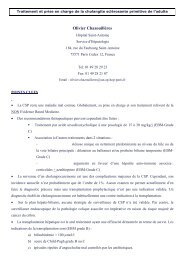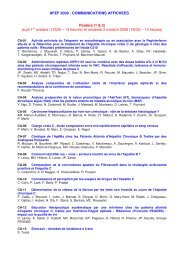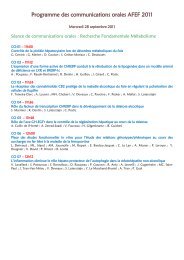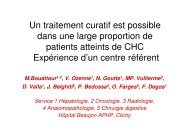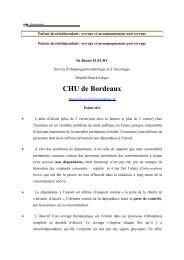Nouveaux marqueurs non invasifs de la maladie du foie - Afef
Nouveaux marqueurs non invasifs de la maladie du foie - Afef
Nouveaux marqueurs non invasifs de la maladie du foie - Afef
Create successful ePaper yourself
Turn your PDF publications into a flip-book with our unique Google optimized e-Paper software.
<strong>Nouveaux</strong> <strong>marqueurs</strong><br />
<strong>non</strong> <strong>invasifs</strong>:<br />
utilisation pronostique<br />
Laurent CASTERA<br />
Service d’Hépatologie, Hôpital Beaujon,<br />
Clichy
Métho<strong>de</strong>s <strong>non</strong> invasives disponibles<br />
2 approches différentes mais complémentaires<br />
Approche « biologique »<br />
Approche « physique »<br />
Bio<strong>marqueurs</strong><br />
E<strong>la</strong>sticité hépatique<br />
Castera & Pinzani. Lancet 2010; 375: 419-20
Bio<strong>marqueurs</strong><br />
Marqueurs « Direct »<br />
Ac Hyaluronique<br />
PIIINP<br />
Laminine<br />
Col<strong>la</strong>gene Type IV<br />
MMP<br />
TIMP-1<br />
TGF-beta<br />
YKL-40<br />
Marqueurs « Indirect »<br />
Taux <strong>de</strong> Prothrombine<br />
Taux <strong>de</strong> P<strong>la</strong>quettes<br />
Ratio ASAT/ALAT
Bio<strong>marqueurs</strong>: scores les plus étudiés<br />
APRI =<br />
AST x 100<br />
P<strong>la</strong>telet<br />
Fibrometre ®<br />
®
E<strong>la</strong>sticité hépatique<br />
FibroScan<br />
Sandrin et al. UMB 2003; 29: 1705-13<br />
Castera, Forns & Alberti. J Hepatol 2008; 48: 835-47
E<strong>la</strong>sticité hépatique<br />
Acoustic Radiation Force Impulse Imaging (ARFI)<br />
Nightingale et al. UMB 2002 ; 28: 227-35<br />
Friedrich-Rust et al. Radiology 2009 ; 252: 595-604
E<strong>la</strong>sticité hépatique<br />
E<strong>la</strong>sto-IRM<br />
+90<br />
Disp<strong>la</strong>cement (µm)<br />
0<br />
-90<br />
E<strong>la</strong>stogram<br />
10<br />
8<br />
6<br />
4<br />
2<br />
0<br />
Shear Stiffness (kPa)<br />
Muthupil<strong>la</strong>i et al. Science 1995; 269: 1854-7<br />
Huwart et al. Gastroenterology 2008; 135: 32-40
over a <strong>la</strong>rge bandwidth. In parallel, SWS provi<strong>de</strong>s<br />
a refined analysis in a <strong>la</strong>rger box of these dispersive properties<br />
of tissues by estimating frequency <strong>de</strong>pen<strong>de</strong>nce of<br />
the shear wave speed.<br />
E<strong>la</strong>sticité hépatique<br />
Statistical methods<br />
The diagnosis performance of FS and SSI are<br />
SuperSonic compared by using receiver operatingImaging<br />
characteristic<br />
(ROC) curves and box-and-whisker curves on the same<br />
1366 Ultrasound in Medicine and Biology cohort. Volume A patient 37, Number was assessed 9, 2011 as positive or negative according<br />
to whether the <strong>non</strong>invasive marker value was<br />
Contrary to FS, as vibration in<strong>du</strong>ced by the radiation greater than or less than to a given cutoff value, respectively.<br />
Connected with any cutoff value is the probability<br />
force creates a short transient excitation, the frequency<br />
bandwidth of the generated shear wave is <strong>la</strong>rge, typically of a true positive (sensitivity) and the probability of a true<br />
ranging from 60 to 600 Hz (Fig. 3). Such wi<strong>de</strong>band negative (specificity). The ROC curve is a plot of<br />
‘‘shear wave spectroscopy’’ can give a refined analysis sensitivity vs. (1-specificity) for all possible cutoff values.<br />
of the complex mechanical behavior of tissue. As shown The most commonly used in<strong>de</strong>x of accuracy is the area<br />
in Figure 3, the shear wave dispersion <strong>la</strong>w can be assessed un<strong>de</strong>r the ROC curve (AUROC), with values close to<br />
from disp<strong>la</strong>cement movies in the region-of-interest. 1.0 indicating high diagnosis accuracy. Optimal cutoff<br />
Thus, the global e<strong>la</strong>sticity imaged by SSI makes use<br />
values for liver stiffness were chosen to maximize the<br />
of higher frequency content and is also influenced by the<br />
sum of sensitivity and specificity and positive and negative<br />
predictive values were computed for these cutoff<br />
dispersive properties of the liver tissues because it averages<br />
the full mechanical response of the liver tissues<br />
values. By using these cutoff values, the agreement<br />
over a <strong>la</strong>rge bandwidth. In parallel, SWS provi<strong>de</strong>s<br />
between FS and SSI was evaluated. Statistical analyses<br />
were performed with Mat<strong>la</strong>b R2007a software (Mathworks,<br />
Natick, MA, USA) using the statistical analysis<br />
a refined analysis in a <strong>la</strong>rger box of these dispersive properties<br />
of tissues by estimating frequency <strong>de</strong>pen<strong>de</strong>nce of<br />
toolbox and Medcalc software (Mariakerke, Belgium).<br />
the shear wave speed.<br />
RESULTS<br />
Statistical methods<br />
The diagnosis performance of FS and SSI are Liver stiffness mapping using SSI<br />
compared by using receiver operating characteristic The Young’s mo<strong>du</strong>lus corresponding to the stiffness<br />
(ROC) curves and box-and-whisker curves on the same of the liver tissues are presented for 4 patients in Figure 4.<br />
cohort. A patient was assessed as positive or negative according<br />
to whether the <strong>non</strong>invasive marker value was sponding B-mo<strong>de</strong> images on which the fat and muscle<br />
The e<strong>la</strong>sticity mapping is superimposed with the corre-<br />
greater than or less than to a given cutoff value, respectively.<br />
Connected with any cutoff value is the probability the e<strong>la</strong>sticity is mapped only in the liver region.<br />
region are well differentiated from the liver region and<br />
of a true positive (sensitivity) and the probability of a true Figure 4a, b, c and d show the e<strong>la</strong>sticity mapping for<br />
negative (specificity). The ROC curve is a plot of patients who have been c<strong>la</strong>ssified as predicted fibrosis<br />
sensitivity vs. (1-specificity) for all possible cutoff values. levels F1, F2, F3 and F4, respectively.<br />
The median e<strong>la</strong>sticity <strong>de</strong>rived from these maps are<br />
Fig. 4. Bidimensional liver e<strong>la</strong>sticity maps assessed using the<br />
supersonic shear imaging (SSI) technique superimposed to<br />
the corresponding B-scan. The Young’s mo<strong>du</strong>lus representing<br />
the liver stiffness is represented in color levels. (a): patient<br />
59 - F1. E 5 4.78 6 0.83 kPa (b): patient 51 - F2. E 5 10.64 6<br />
1.10 kPa (c): patient 39 - F3. E 5 14.52 6 2.20 kPa (d): patient<br />
Muller et al. UMB 2009; 35: 219-29<br />
Bavu et al. UMB 2011;37: 1361-73
Bio<strong>marqueurs</strong> vs. FibroScan<br />
Avantages & inconvénients<br />
Critères Bio<strong>marqueurs</strong> FibroScan<br />
Détection cirrhose<br />
Bonnes<br />
performances<br />
Meilleures<br />
performances<br />
Applicabilité 95% 81%<br />
Rapidité résultats 1-3 jours 10 min<br />
Castera L. Gastroenterology 2012; in press
P<strong>la</strong>n<br />
Intérêt pour prédire les complications<br />
- Hypertension portale<br />
- Carcinome hépatocellu<strong>la</strong>ire<br />
Intérêt pour prédire <strong>la</strong> survie
-TSAO ET AL.<br />
Now There Are Many (Stages) Where Before There<br />
Was One: In Search of a Pathophysiological<br />
C<strong>la</strong>ssification of Cirrhosis<br />
Guadalupe Garcia-Tsao, 1 Scott Friedman, 2 John Iredale, 3 and Massimo Pinzani 4<br />
HEPATOLO<br />
HEPATOLOGY, Vol. 51, No. 4, 2010<br />
changes, and more faithfully reflects its progression, notably activated reversibility<br />
and prognosis, ultimately linkingbrob<strong>la</strong>sts, these param-<br />
as well as key cytokines su<br />
hepatic stel<strong>la</strong>te ce<br />
eters to clinically relevant outcomes andgrowth therapeutic factor and transforming grow<br />
strategies. The Child-Pugh and Mo<strong>de</strong>l for roles End-Stage of bone marrow–<strong>de</strong>rived cells a<br />
epithelial-mesenchymal transition a<br />
Liver Disease (MELD) scores are currently <strong>de</strong>ployed to<br />
tion, but it is unlikely that these sour<br />
<strong>de</strong>fine prognosis by mo<strong>de</strong>ling hepatic dysfunction, but do<br />
provi<strong>de</strong> a major contribution to hep<br />
not provi<strong>de</strong> direct evi<strong>de</strong>nce of the stage or dynamic trix in chronic state human liver disease<br />
of cirrhosis. The need for more refined cirrhosis proteases staging thatis<strong>de</strong>gra<strong>de</strong> scar and the p<br />
especially germane given the increasing use them of effective are better un<strong>de</strong>rstood. Moreo<br />
antiviral treatments in patients with hepatitis un<strong>de</strong>rstanding B virus of distinctive pathoge<br />
(HBV) and hepatitis C virus (HCV) cirrhosis at different and thestages and from differ<br />
emergence of effective antifibrotic agents, that wherein fibrosiswe<br />
may be customized acco<br />
and un<strong>de</strong>rlying cause.<br />
must <strong>de</strong>fine favorable or unfavorable endpoints that corre<strong>la</strong>te<br />
with a discrete clinical outcome in patients with<br />
Cirrhosis in experimental mo<strong>de</strong>l<br />
may be reversible. 24 Following withd<br />
cirrhosis.<br />
stimulus, a <strong>de</strong>nse microno<strong>du</strong><strong>la</strong>r cirrh<br />
The normal liver has only a small amount mo<strong>de</strong>ling of fibrous to a more attenuated, m<br />
tissue in re<strong>la</strong>tion to its size. As a result of continued However, liver some septa will persist, like<br />
injury, however, there is progressive accumu<strong>la</strong>tion <strong>la</strong>id down of early extracellu<strong>la</strong>r<br />
matrix, or scar. Although different“mature” chronic liver (i.e., cross-linked).<br />
in the injury and ar<br />
diseases are characterized by distinct patternsMoreover, of fibrosisin experimental mo<strong>de</strong><br />
<strong>de</strong>position, 1 may be the site of neoangiogenesis.<br />
the <strong>de</strong>velopment of cirrhosis represents a<br />
already present in chronic inf<strong>la</strong>mm<br />
common outcome leading to simi<strong>la</strong>r clinical<br />
concurrent<br />
consequences<br />
that impose an increasing bur<strong>de</strong>n inaclinical role prac-<br />
the pathogenesis of portal<br />
with the fibrogenic proce<br />
tice.<br />
effectiveness of therapeutic angioge<br />
only improving fibrosis, but also in<br />
For more than a century and a half, the <strong>de</strong>scription<br />
of a liver as “cirrhotic” was sufficient to connote<br />
both a pathological and clinical status, and to assign<br />
the prognosis of a patient with liver disease. However,<br />
as our interventions to treat advanced liver disease<br />
have progressed (e.g., antiviral therapies), the ina<strong>de</strong>quacy<br />
of a simple one-stage <strong>de</strong>scription for advanced fibrotic<br />
liver disease has become increasingly evi<strong>de</strong>nt. Until recently,<br />
refining the diagnosis of cirrhosis into more than<br />
one stage hardly seemed necessary when there were no<br />
interventions avai<strong>la</strong>ble to arrest its progression. Now,<br />
however, un<strong>de</strong>rstanding the range of potential outcomes<br />
based on the severity of cirrhosis is essential in or<strong>de</strong>r to<br />
predict outcomes and indivi<strong>du</strong>alize therapy. This position<br />
paper, rather than providing clinical gui<strong>de</strong>lines, attempts<br />
to catalyze a reformu<strong>la</strong>tion of the concept of cirrhosis<br />
from a static to a dynamic one, creating a temp<strong>la</strong>te for<br />
further refinement of this concept in the future.<br />
We already make the clinical distinction between compensated<br />
and <strong>de</strong>compensated cirrhosis, and are incrementally<br />
linking these clinical entities to quantitative variables<br />
such as portal pressure measurements and emerging <strong>non</strong>invasive<br />
diagnostics. Moreover, mounting evi<strong>de</strong>nce suggests<br />
that cirrhosis encompasses a pathological spectrum<br />
which is neither static nor relentlessly progressive, but<br />
rather dynamic and bidirectional, at least in some pa-<br />
cation of chronic tients. liver Thus, disease there a pressing basedneed on histological, re<strong>de</strong>fine cirrhosis Garcia-Tsao clinical, hemodynamic, et al. Hepatology and biological 2010; sure, parameters. is suggested 51: 1445-9. by dataIn fromthe anima<br />
Anatomical-Pathological Context<br />
n<br />
, there is no clinical a manner<br />
evi<strong>de</strong>nce<br />
that better<br />
of<br />
recognizes<br />
cirrhosis,<br />
itsthe un<strong>de</strong>rlying<br />
HVPGre<strong>la</strong>tion-<br />
been established in humans.<br />
is below 6 mmHg, and at this stage there is fibrogenesis and 27 Altho<br />
ne
Un peu d’histoire<br />
“ Quand le <strong>foie</strong> est <strong>du</strong>r<br />
le pronostic est mauvais ”<br />
Socrate (V ème siècle av J.C)
Mesure <strong>de</strong> l’é<strong>la</strong>sticité hépatique<br />
Normale<br />
5.5<br />
Cirrhose<br />
15<br />
?<br />
65<br />
3<br />
75 kPa
Valeur pronostique <strong>de</strong> l’é<strong>la</strong>sticité<br />
hépatique au cours <strong>de</strong> <strong>la</strong> cirrhose ?<br />
15 27 49 54<br />
75<br />
63 kPa<br />
VO gra<strong>de</strong> II / III<br />
Ascite<br />
N=711 patients CLD<br />
F3F4 144<br />
CHC<br />
RVO<br />
Foucher et al. Gut 2006; 55: 403-8.
P<strong>la</strong>n<br />
Intérêt pour prédire les complications<br />
- Hypertension portale<br />
- Carcinome hépatocellu<strong>la</strong>ire<br />
Intérêt pour prédire <strong>la</strong> survie
Importance <strong>du</strong> gradient portal (HVPG)<br />
HVPG<br />
≥ 10 mm Hg<br />
Risque<br />
Formation <strong>de</strong> VO<br />
Décompensation<br />
CHC<br />
≥ 12 mm Hg<br />
≥ 16 mm Hg<br />
Rupture <strong>de</strong> VO<br />
Décès<br />
Garcia-Tsao & Bosch. N Engl J Med 2010; 362: 823-32
Corré<strong>la</strong>tion é<strong>la</strong>sticité hépatique et HVPG<br />
30<br />
24<br />
Pearson’s coefficient = 0.84<br />
p < 0.001<br />
HVPG (mm Hg)<br />
18<br />
12<br />
6<br />
0<br />
0<br />
8<br />
16<br />
24<br />
32<br />
40<br />
48<br />
56<br />
64<br />
72<br />
80<br />
Liver stiffness (kPa)<br />
N= 124 patients avec<br />
récidive VHC post TH Carrion et al. Liver Transpl 2006; 12: 1791-8.
Corre<strong>la</strong>tion é<strong>la</strong>sticité hépatique et HVPG<br />
HEPATOLOGY, Vol. 45, No. 5, 2007<br />
oui… mais<br />
R²= 0.61<br />
P
Corre<strong>la</strong>tion é<strong>la</strong>sticité hépatique et HVPG<br />
HEPATOLOGY, Vol. 45, No. 5, 2007<br />
oui… mais<br />
R²= 0.61<br />
P10-12 mmHg<br />
R²= 0.67<br />
<strong>la</strong> pression P
Corré<strong>la</strong>tion avec les Varices<br />
Oesophagiennes<br />
P
Prédiction <strong>de</strong>s VO gra<strong>de</strong> II-III<br />
Fibroscopie AUROC = évitée 0.83 69 %<br />
46%<br />
54%<br />
3 19<br />
75<br />
VO < II<br />
95%<br />
4 patients<br />
Mal c<strong>la</strong>ssés<br />
VO ≥ II<br />
48%<br />
47 patients<br />
Mal c<strong>la</strong>ssés<br />
Kazemi et al. J Hepatol 2006; 45: 230-5
Performance pour <strong>la</strong> prédiction <strong>de</strong>s VO<br />
FibroScan<br />
ients Patients Authors, Etiologies Etiologies<br />
PatientsStudy<br />
Etiologies Child-Pugh Child-Pugh Study End<br />
(n) [Ref.] <strong>de</strong>sign (n) <strong>de</strong>sign A (%) A <strong>de</strong>sign (%) point<br />
]<br />
]<br />
]<br />
]<br />
]<br />
]<br />
]<br />
]<br />
165 Kazemi CLD CLDRetro.<br />
165 Retro. CLD n.a. n.a. Retro. OV<br />
et al., [45] mono. mono. mono. LOV<br />
End Prevalence Child-Pugh Prevalence Cut-offs End AUC Cut-offs Prevalence Se AUC SpCut-offs<br />
SePPV<br />
Sp AUC NPV PPV Se +LR NPV Sp -LR +LR Saved PPV -LR NPV Saved +LR<br />
point OV A (%)<br />
OV (kPa) (%) point (kPa) OV (%) (%)(kPa)<br />
(%) (%) (%) (%) (%) (%) (%) endoscopy (%) (%)<br />
(%)<br />
endos<br />
(%)<br />
OV 45 n.a.<br />
LOV 28<br />
4513.9<br />
OV<br />
2819.0<br />
LOV<br />
0.83 13.9 45<br />
0.84 19.0 28<br />
95<br />
91<br />
0.83 43 13.9 9557<br />
0.84 60 19.0 9148<br />
47 Vizzutti HCV HCV Pro. 47 Pro. HCV 60 60 Pro. OV OV 660 6617.6 OV 0.76 17.6 66 90 0.76 43 17.6 9077 430.76 66 7790 1.6 6643 0.23 1.6 74 77 0.23 66 741.6<br />
et al., [36] mono. mono. mono.<br />
211 Pritchett CLD CLDRetro.<br />
211 Retro. CLD n.a. n.a. Retro. OV<br />
et al., [48] mono. mono. mono. LOV<br />
OV<br />
n.a.<br />
LOV 37<br />
n.a. 19.5 OV<br />
3719.8<br />
LOV<br />
89 Bureau CLD CLDPro.<br />
89 Pro. CLD 34 34 Pro. OV OV 72 34 7221.1<br />
OV<br />
et al., [37] mono. mono. mono. LOV LOV 48 4829.3<br />
LOV<br />
70 Castera HCV HCV Retro. 70 Retro. HCV 100 100 Retro. OV OV 36 100 3621.5<br />
OV<br />
et al., [46] mono. mono. mono. LOV LOV 19 1930.5<br />
LOV<br />
0.74 19.5 n.a. 76<br />
0.76 19.8 37 91<br />
0.85 21.1 72<br />
0.76 29.3 48<br />
0.84 21.5 36<br />
0.87 30.5 19<br />
84<br />
81<br />
76<br />
77<br />
0.74 66 19.5 7656<br />
0.76 56 19.8 91 91<br />
0.85 71 21.1 84<br />
0.76 61 29.3 81<br />
0.84 78 21.5 7668<br />
0.87 85 30.5 7756<br />
102 Pineda, HIV-HCV HIV-HCV Pro. 102 Pro. HIV-HCV 76 76 Pro. CROV* CROV* 13 76 1321.0 CROV* 0.71 21.0 13 100 0.71 32 21.0 100 25 320.71 100 25100 1.5 100 32 0.0 1.5 44 25 0.0 100 441.5<br />
et al., [47] multi. multi. multi.<br />
183 Nguyen CLD CLDRetro.<br />
183<br />
58 et HCV/HBV al. [49] HCV/HBV mono. 58<br />
103 Alcohol Alcohol 103<br />
Retro. CLD 63 63 Retro. LOV LOV 22 63 2248.0<br />
LOV 0.76 48.0 22<br />
mono. HCV/HBV mono. 17 1719.8<br />
0.73 19.8 17<br />
Alcohol<br />
25 2547.2<br />
0.77 47.2 25<br />
73<br />
89<br />
85<br />
0.76 73 48.0 7344<br />
0.73 55 19.8 8927<br />
0.77 64 47.2 8544<br />
124 Malik CLD CLDRetro.<br />
124 Retro. CLD n.a. n.a. Retro. OV OV 51 n.a. 5120.0 OV 0.85 20.0 51 n.a. 0.85 n.a. 20.0 n.a. 80 n.a. 0.85 75 80n.a. 75n.a. n.a. 80 n.a. 75 n.a.<br />
et al., [50] mono. mono. mono.<br />
430.83<br />
91<br />
60.84<br />
95<br />
660.74<br />
82<br />
560.76<br />
55<br />
710.85<br />
610.76<br />
780.84<br />
850.87<br />
94<br />
730.76<br />
90<br />
550.73<br />
97<br />
640.77<br />
93<br />
5795<br />
1.7<br />
4891<br />
2.3<br />
5676<br />
2.2<br />
91 91 2.1<br />
9143<br />
0.13<br />
9560<br />
0.14<br />
8266<br />
0.36<br />
556<br />
0.16<br />
1.7 66 57<br />
2.3 69 48<br />
2.2 n.a. 56<br />
2.1 69 91<br />
Thabut, Moreau & Lebrec. Hepatology 2011; 53: 683-94<br />
Castera, Pinzani & Bosch. J Hepatol 2012; in press<br />
84 2.9<br />
81 2.1<br />
6876<br />
3.5<br />
5677<br />
5.1<br />
4473<br />
2.7<br />
2789<br />
2.0<br />
4485<br />
2.4<br />
71 0.22<br />
61 0.31<br />
8478<br />
0.31<br />
9485<br />
0.27<br />
9073<br />
0.37<br />
9755<br />
0.20<br />
9364<br />
0.23<br />
2.9 81<br />
2.1 71<br />
3.5 73 68<br />
5.1 79 56<br />
2.7 73 44<br />
2.0 60 27<br />
2.4 69 44<br />
0.13 91<br />
0.14 95<br />
0.36 82<br />
0.16 55<br />
0.22<br />
0.31<br />
0.31 84<br />
0.27 94<br />
0.37 90<br />
0.20 97<br />
0.23 93<br />
661.7<br />
692.3<br />
n.a. 2.2<br />
692.1<br />
812.9<br />
712.1<br />
73.5<br />
795.1<br />
732.7<br />
602.0<br />
692.4
Performance pour <strong>la</strong> prédiction <strong>de</strong>s VO<br />
Bio<strong>marqueurs</strong><br />
Test, Patients<br />
[Ref.] (n)<br />
Etiologies Test, PatientsStudy<br />
Etiologies Patients Child-Pugh Study EtiologiesEnd<br />
Child-Pugh Study Prevalence Child-Pugh End Cut-offs Prevalence End AUCPrevalence<br />
Cut-offs Se Sp AUCut-offs<br />
PPV Se<br />
[Ref.] (n) <strong>de</strong>sign (n) A (%) <strong>de</strong>sign point A <strong>de</strong>sign (%) OV A point (%)<br />
(kPa) OV point (%) OV (kPa)<br />
(%) (%)(kPa)<br />
(%)<br />
AUC Sp NPV<br />
(%)<br />
PPV Se +LR Sp NPV -LRPPV<br />
+LR Saved NPV -LR +LRSaved<br />
-LR<br />
(%)<br />
(%) (%) endoscopy (%) endoscopy<br />
(%) (%)<br />
P<strong>la</strong>telet 510 CLD P<strong>la</strong>telet 510 Retro. CLD 510 79Retro.<br />
CLD CROV* 79Retro.<br />
2879 CROV* 89 28CROV* 0.6528 89 55 75 0.65 894955 0.65 75 80 49 55 2.17 75 80.61492.17 66 800.61 2.17 66 0.61<br />
count, [54] count, [54] multi. multi. multi.<br />
AST/ALT 510 CLD AST/ALT 510 Retro. CLD 510 79Retro.<br />
CLD CROV* 79Retro.<br />
2879 CROV* 1.1 28CROV* 0.6428 1.1 71 57 0.64 1.16071 0.64 57 82 60 71 1.63 57 82 0.52601.63 61 820.52 1.63 61 0.52<br />
ratio, [54] ratio, [54] multi. multi. multi.<br />
APRI, 510 [54] CLD APRI, 510 [54] Retro. CLD 510 79Retro.<br />
CLD CROV* 79Retro.<br />
2879 CROV* 1.5 28CROV* 0.5728 1.5 57 0.57 1.53557 0.57 76 357 1.30 57 0.76351.30 57 760.76 1.30 57 0.76<br />
multi. multi. multi.<br />
Forns’, 510 CLD Forns’, 510 Retro. CLD 510 79Retro.<br />
CLD CROV* 79Retro.<br />
2879 CROV* 8.8 28CROV* 0.6628 8.8 71 62 0.66 8.85871 0.66 62 82 58 71 1.88 62 82 0.47581.88 66 820.47 1.88 66 0.47<br />
in<strong>de</strong>x, [54] in<strong>de</strong>x, [54] multi. multi. multi.<br />
Lok 510 CLD Lok 510 Retro. CLD 510 79Retro.<br />
CLD CROV* 79Retro.<br />
2879 CROV* 1.5 28CROV* 0.7028 1.5 71 68 0.70 1.55071 0.70 68 84 50 71 2.25 684 0.42502.25 69 840.42 2.25 69 0.42<br />
in<strong>de</strong>x, [54] in<strong>de</strong>x, [54] multi. multi. multi.<br />
Fib-4, 510 [54] CLD Fib-4, 510 [54] Retro. CLD 510 79Retro.<br />
CLD CROV* 79Retro.<br />
2879 CROV* 4.3 28CROV* 0.6328 4.3 71 56 0.63 4.34071 0.63 56 82 40 71 1.60 56 82 0.53401.60 820.53 1.60 60 0.53<br />
multi. multi. multi.<br />
Fibroin<strong>de</strong>x, 510 CLD Fibroin<strong>de</strong>x, 510 Retro CLD 510 79Retro<br />
CLD CROV* 79Retro<br />
2879 CROV* 2.5 28CROV* 0.6528 2.5 51 76 0.65 2.55051 0.65 76 75 50 51 2.06 76 75 0.65502.06 70 750.65 2.06 70 0.65<br />
[54] [54] multi. multi. multi.<br />
Fibrotest®, 99 CLD Fibrotest®, 99 Retro. CLD 99 42Retro.<br />
CLD LOV 42Retro.<br />
7242 LOV 0.85 72LOV 0.772 0.8584 53 0.77 0.85 8684 0.77 53 50 86 84 1.78 53 50.28861.78 500.28<br />
1.78 0.28<br />
[55] [55] mono. mono. mono.<br />
PC/SDR, 218 CLD PC/SDR, 218 Pro. CLD 218 51Pro.<br />
CLD OV 51Pro.<br />
5451 OV 909 54OV 0.8654 90992 67 0.86 9097792 0.86 67 87 77 92 2.77 67 87 0.13772.77 80 870.13 2.77 80 0.13<br />
[56] [56] multi. multi. multi.<br />
Capsule 288 CLD Capsule 288 Pro. CLD 288 69Pro.<br />
CLD OV 69Pro.<br />
6369 OV n.a. 63OV<br />
endoscopy,<br />
[57]<br />
endoscopy, multi.<br />
[57]<br />
multi. LOV multi. 27 LOV n.a. 27LOV<br />
Lapalus 120 CLD Lapalus 120 Pro. CLD 120 48Pro.<br />
CLD OV 48Pro.<br />
6248 OV n.a. 62OV<br />
et al., [58] et al., [58] multi. multi. LOV multi. 29 LOV n.a. 29LOV<br />
n.a. 63 n.a. 84<br />
n.a. 27 n.a. 78<br />
n.a. 62 n.a. 77<br />
n.a. 29 n.a. 77<br />
88 n.a. n.a. 9284<br />
96 n.a. n.a. 8778<br />
86 n.a. n.a. 9077<br />
88 n.a. n.a. 7577<br />
n.a. 88 77<br />
n.a. 96 92<br />
n.a. 86 69<br />
n.a. 88 90<br />
92 84 7.00 88 77 0.18927.00<br />
86 770.18<br />
7.00 86<br />
878<br />
19.5096<br />
92 0.238719.50<br />
79 920.23<br />
19.50 79<br />
90 77 5.42 869<br />
0.28905.42<br />
690.28<br />
5.42<br />
75 77 6.69 88 90.26756.69<br />
85 900.26 6.69 85<br />
Thabut, Moreau & Lebrec. Hepatology 2011; 53: 683-94<br />
Castera, Pinzani & Bosch. J Hepatol 2012; in press<br />
0.18<br />
0.23<br />
0.28<br />
0.26
Performance pour <strong>la</strong> prédiction <strong>de</strong>s VO<br />
Bio<strong>marqueurs</strong> vs. FibroScan<br />
Endoscopies évitées<br />
VO<br />
VO II-III<br />
Ratio ASAT/ALAT<br />
In<strong>de</strong>x <strong>de</strong> Lok<br />
FibroScan<br />
Fibrotest<br />
Taux <strong>de</strong> Prothrombine<br />
Taux <strong>de</strong> p<strong>la</strong>quettes<br />
APRI<br />
81%<br />
77%<br />
73%<br />
70%<br />
70%<br />
69%<br />
66%<br />
76%<br />
77%<br />
79%<br />
64%<br />
79%<br />
76%<br />
63%<br />
N=70 patients cirrhose C<br />
Castera et al. J Hepatol 2009; 50: 59-68.
Combinaison é<strong>la</strong>sticité hépatique<br />
taille <strong>de</strong> <strong>la</strong> rate + p<strong>la</strong>quettes = LSPS<br />
Liver stiffness Spleen diameter to P<strong>la</strong>telet ratio Score<br />
LSPS =<br />
LSM (kPa) x Spleen diameter (cm)<br />
P<strong>la</strong>telet (10 9 /L)<br />
N = 401 patients VHB cirrhotiques (evaluation 280; validation 121)<br />
VO « haut risque » (Baveno V): 32%<br />
Kim et al. Am J Gastroenterol 2010; 105:1382-90
LSPS<br />
Performance détection VO à «haut risque »<br />
Fibroscopie AUROC évitée 0.95 83%<br />
62.8%<br />
24.8%<br />
3.5 5.5<br />
Absence <strong>de</strong> VOHR<br />
95%<br />
VOHR +<br />
93%<br />
Kim et al. Am J Gastroenterol 2010; 105:1382-90
1658<br />
LIVER LIVER<br />
Kim et al.<br />
Entire popu<strong>la</strong>tion (n = 577)<br />
1658<br />
LIVER<br />
1.0<br />
LSPS<br />
Patients with LSPS ≥ 5.5<br />
Risque<br />
Entire<br />
<strong>de</strong> rupture <strong>de</strong> VO<br />
Patients popu<strong>la</strong>tion with (n LSPS = 577) 3.5–5.5<br />
Cumu<strong>la</strong>tive EV bleeding risk<br />
Cumu<strong>la</strong>tive EV bleeding risk<br />
Kim et al.<br />
0.8<br />
1.0<br />
0.6<br />
0.8<br />
0.60.4<br />
0.40.2<br />
0.20.0<br />
Cumu<strong>la</strong>tive EV bleeding risk<br />
0<br />
Patients with Entire LSPS popu<strong>la</strong>tion < 3.5 (n = 577)<br />
Patients with LSPS ≥ 5.5<br />
1.0<br />
Patients with LSPS Patients 3.5–5.5 with LSPS ≥ 5.5<br />
Patients with LSPS < 3.5<br />
Patients with LSPS 3.5–5.5<br />
0.8<br />
0.6<br />
0.4<br />
0.2<br />
Patients with LSPS < 3.5<br />
1 2 3 4<br />
No. at 0.0 risk<br />
Years<br />
0.0<br />
No. at risk<br />
Patients with<br />
0 107 1 76 2 51 3 33 4 18<br />
LSPS N=577 ≥ 5.5 patients VHB<br />
Subgroup 2<br />
Kim et al. Am J Gastroenterol 2011; 106:1654-62<br />
No. at risk<br />
0.0<br />
Years<br />
Patients with<br />
Subgroup 1<br />
Cumu<strong>la</strong>tive EV bleeding risk<br />
1.0<br />
0.8<br />
0.6<br />
0.4<br />
0.2<br />
Cumu<strong>la</strong>tive EV bleeding risk<br />
1<br />
0<br />
0<br />
0<br />
0<br />
0<br />
0
Résumé<br />
<br />
L’é<strong>la</strong>sticité hépatique est bien corrélée avec le<br />
gradient portal et <strong>la</strong> présence (taille?) <strong>de</strong>s VO.<br />
<br />
Les performances <strong>de</strong> l’é<strong>la</strong>stométrie et <strong>de</strong>s<br />
bio<strong>marqueurs</strong> sont cependant insuffisantes pour<br />
remp<strong>la</strong>cer <strong>la</strong> fibroscopie pour <strong>la</strong> recherche <strong>de</strong><br />
VO.
P<strong>la</strong>n<br />
Intérêt pour prédire les complications<br />
- Hypertension portale<br />
- Carcinome hépatocellu<strong>la</strong>ire<br />
Intérêt pour prédire <strong>la</strong> survie
factors consi<strong>de</strong>red significant are ol<strong>de</strong>r age, male gen<strong>de</strong>r,<br />
and serum albumin level.<br />
L<br />
Liaisons dangereuses ?<br />
chro<br />
liver<br />
adva<br />
error<br />
p
E<strong>la</strong>sticité hépatique & cancer <strong>du</strong> <strong>foie</strong><br />
890 JUNG, KIM, ET AL.<br />
Hépatite B<br />
N= 1130 patients VHB<br />
using LSM an<br />
ferences in the<br />
nalysis, we ass<br />
histology at en<br />
patients had L<br />
>13 kPa. In p<br />
of HCC estim<br />
cantly differe<br />
5.1%) and p<br />
(0.87% versus<br />
contrast, amo<br />
<strong>de</strong>veloped m<br />
diagnosed ac<br />
55.9%) than w<br />
Jung et al. Hepatology 2011; 53: 885-94
P<strong>la</strong>n<br />
Intérêt pour prédire les complications<br />
- Hypertension portale<br />
- Carcinome hépatocellu<strong>la</strong>ire<br />
Intérêt pour prédire <strong>la</strong> survie
E<strong>la</strong>sticité hépatique & survie<br />
Koch et al. Critical Care 2011, 15:R266<br />
en réanimation<br />
http://ccforum.com/content/15/6/R266<br />
Page 5 of 15<br />
Figure 1 Liver stiffness measurements in the intensive care unit (ICU) setting. Critically ill medical patients were inclu<strong>de</strong>d into this study<br />
uponN=108 admission topatients; the ICU. Transient 8 liver cirrhotiques<br />
e<strong>la</strong>stography was assessed at admission, on Day 3, on Day 7, and subsequently once per week. The<br />
setting of our study is disp<strong>la</strong>yed in the upper panel; stiffness measurements were performed at the bedsi<strong>de</strong> with a portable FibroScan ®<br />
apparatus, alongsi<strong>de</strong> c<strong>la</strong>ssical hemodynamic and respiratory monitoring as well as typical ICU treatment measures. The numbers of patients<br />
Koch et al. Crit Care 2011; 15: R266
Page 11 of 15<br />
Page 11 of 15<br />
Koch et al. Critical<br />
E<strong>la</strong>sticité<br />
Care 2011, 15:R266<br />
hépatique<br />
Koch et al. Critical Care 2011,<br />
&<br />
15:R266<br />
survie<br />
http://ccforum.com/content/15/6/R266<br />
http://ccforum.com/content/15/6/R266<br />
Page 12 of 1<br />
en réanimation<br />
Survie en réanimation<br />
Survie après sortie réanimation<br />
Sans cirrhose<br />
Sans cirrhose<br />
Koch et al. Crit Care 2011; 15: R266
S<br />
an<br />
: 0.815 (0.727-0.903)<br />
1.0<br />
the prediction of liver<br />
0.2<br />
E<strong>la</strong>sticité hépatique<br />
survie<br />
0.0<br />
sans complications<br />
0 200 400 600 800<br />
Days<br />
84.1%, respectively<br />
B<br />
1.0<br />
LS
ICAL–LIVER,<br />
CLINICAL–LIVER,<br />
PANCREAS, AND AND<br />
IARY BILIARY TRACT TRACT<br />
E<strong>la</strong>sticité hépatique & survie<br />
Figure 2. Overall survival probability according to liver stiffness, biomarkers, and liver biopsy. (A) O<br />
N=1457 Figure patients 2. Overall VHC<br />
the diagnosis of severe survival fibrosis Vergniol probability or cirrhosis. et according al. (B) Overall Gastroenterology to survival liver stiffness, according biomarkers, 2011; to different 140: and cut-offs 1970-9 liver biops of live
Bio<strong>marqueurs</strong> & survie<br />
Fibrotest<br />
Overall survival probability according to liver stiffness, biomarkers, and liver biopsy. (A) Overall survival according to published cut-offs for<br />
sis of severeN=537 fibrosis or cirrhosis. patients (B) Overall VHC survival according to different cut-offs of N=1457 liver stiffness patients (kPa). OverallVHC<br />
survival (95% confi<strong>de</strong>nce<br />
ing liver stiffness: 9.5 kPa: 96% (94%–98%); 9.5 kPa: 77% (72%–82%); 20 kPa: 66% (61%–71%); 30 kPa: 57% (50%–64%); 40<br />
37%–57%); Ngo et 50 al. kPa: Clin 42% Chem (29%–55%). 2006; (C) 52: Overall 1887-96 survival according to different cut-offs of FibroTest. Overall survival (95% confi<strong>de</strong>nce<br />
Vergniol et al. Gastroenterology 2011; 140: 1970-9
Bio<strong>marqueurs</strong> & survie<br />
ELF score<br />
Hepatology<br />
p<strong>la</strong>neMeier curve of<br />
s from liver-re<strong>la</strong>ted<br />
anced liver fibrosis<br />
p<strong>la</strong>neMeier curve of<br />
s from liver-re<strong>la</strong>ted<br />
sy. *HRs <strong>de</strong>rived<br />
ional hazards mo<strong>de</strong>l<br />
sted for age, gen<strong>de</strong>r,<br />
ion, smoking,<br />
disease, treatment<br />
tre of recruitment.<br />
N=457 patients<br />
Parkes et al. Gut 2010; 59: 1245-51
CPT in predicting 1-year mortality. As expected, the performance<br />
of each in<strong>de</strong>x / test <strong>de</strong>teriorated at <strong>la</strong>ter time points but HA and CPT<br />
remained highly predictive at year 3, and HA at year 5. Figure 1<br />
shows survival plots for several of the predictors<br />
APRI<br />
of a liver-re<strong>la</strong>ted<br />
0.0<br />
outcome using the cutoff values as shown. As <strong>de</strong>monstrated in the<br />
Years<br />
Surv<br />
Bio<strong>marqueurs</strong> & survie<br />
0.2<br />
0 1 2 3 4 5 6 7<br />
Surv<br />
1.0<br />
APRI<br />
1.0<br />
CPT<br />
0.8<br />
< 1.5<br />
0.8<br />
≤ 6<br />
Survival function<br />
0.6<br />
0.4<br />
> 1.5<br />
Survival function<br />
0.6<br />
0.4<br />
> 6<br />
Survival function<br />
0.2<br />
0.2<br />
7<br />
0.0<br />
0 1 2 3 4 5 6 7<br />
Years<br />
0.0<br />
0 1 2 3 4 5 6 7<br />
Years<br />
MELD<br />
N=303patients<br />
1.0<br />
VHC; Figure 207 1 . Survival VIH curves for each of the assessed markers using the cutoff values s<br />
Nunes et al. Am J Gastroenterol 2010; 105: 1346-53
Métho<strong>de</strong>s <strong>non</strong> invasives & survie<br />
résumé<br />
Tests<br />
Patients<br />
n<br />
Etiologie<br />
Type étu<strong>de</strong><br />
Durée suivi<br />
Complications<br />
n<br />
AUC<br />
Décès<br />
n/n*<br />
AUC<br />
Fibrotest®<br />
537<br />
VHC<br />
Prospective<br />
5 ans<br />
29<br />
0.96<br />
20/9<br />
0.95<br />
1457<br />
VHC<br />
Prospective<br />
5 ans<br />
-<br />
-<br />
77/39<br />
0.80<br />
1074<br />
VHB<br />
Retro + prospective<br />
4 ans<br />
50<br />
0.89<br />
36/27<br />
0.94<br />
218<br />
OH<br />
Prospective<br />
8 ans<br />
-<br />
-<br />
85/42<br />
0.79<br />
Fibrometre®<br />
218<br />
OH<br />
Prospective<br />
8 ans<br />
-<br />
-<br />
85/42<br />
0.80<br />
Hepascore®<br />
218<br />
OH<br />
Prospective<br />
8 ans<br />
-<br />
-<br />
85/42<br />
0.78<br />
APRI<br />
303<br />
VIH-VHC<br />
Prospective<br />
3 ans<br />
-<br />
-<br />
79/33<br />
0.88<br />
FIB-4<br />
303<br />
VIH-VHC<br />
Prospective<br />
3 ans<br />
-<br />
-<br />
79/33<br />
0.87<br />
ELF®<br />
161<br />
CBP<br />
Prospective<br />
7 ans<br />
42<br />
0.68<br />
1<br />
-<br />
457<br />
MCF<br />
Prospective<br />
7 ans<br />
61<br />
0.87<br />
39<br />
-<br />
E<strong>la</strong>stométrie<br />
100<br />
MCF<br />
Prospective<br />
2 ans<br />
41<br />
0.84<br />
0<br />
-<br />
1457<br />
VHC<br />
Prospective<br />
5 ans<br />
-<br />
-<br />
77/39<br />
0.82
Take Home messages<br />
<br />
Les métho<strong>de</strong>s <strong>non</strong> invasives sont utilisées <strong>de</strong> façon<br />
croissante en pratique notamment pour le diagnostic <strong>de</strong><br />
cirrhose mais ne peuvent remp<strong>la</strong>cer <strong>la</strong> fibroscopie pour <strong>la</strong><br />
recherche <strong>de</strong>s VO.<br />
<br />
La mesure <strong>de</strong> l’é<strong>la</strong>sticité hépatique pourrait être<br />
intéressante pour c<strong>la</strong>sser les patients cirrhotiques en<br />
groupes à risque en termes <strong>de</strong> complications et <strong>de</strong> survie.


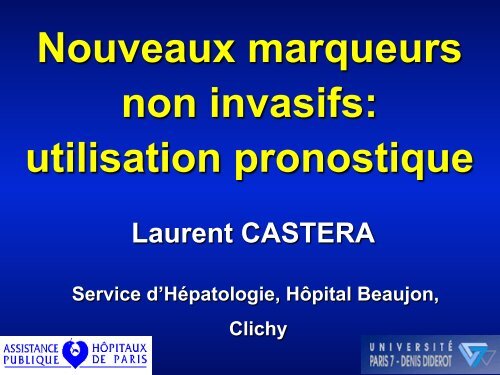
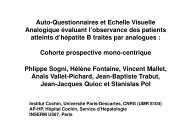



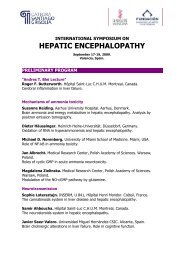
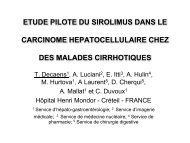


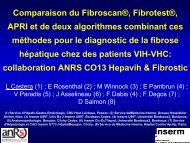
![(Microsoft PowerPoint - C56.ppt [Lecture seule] [Mode de ... - Afef](https://img.yumpu.com/44064904/1/190x134/microsoft-powerpoint-c56ppt-lecture-seule-mode-de-afef.jpg?quality=85)
